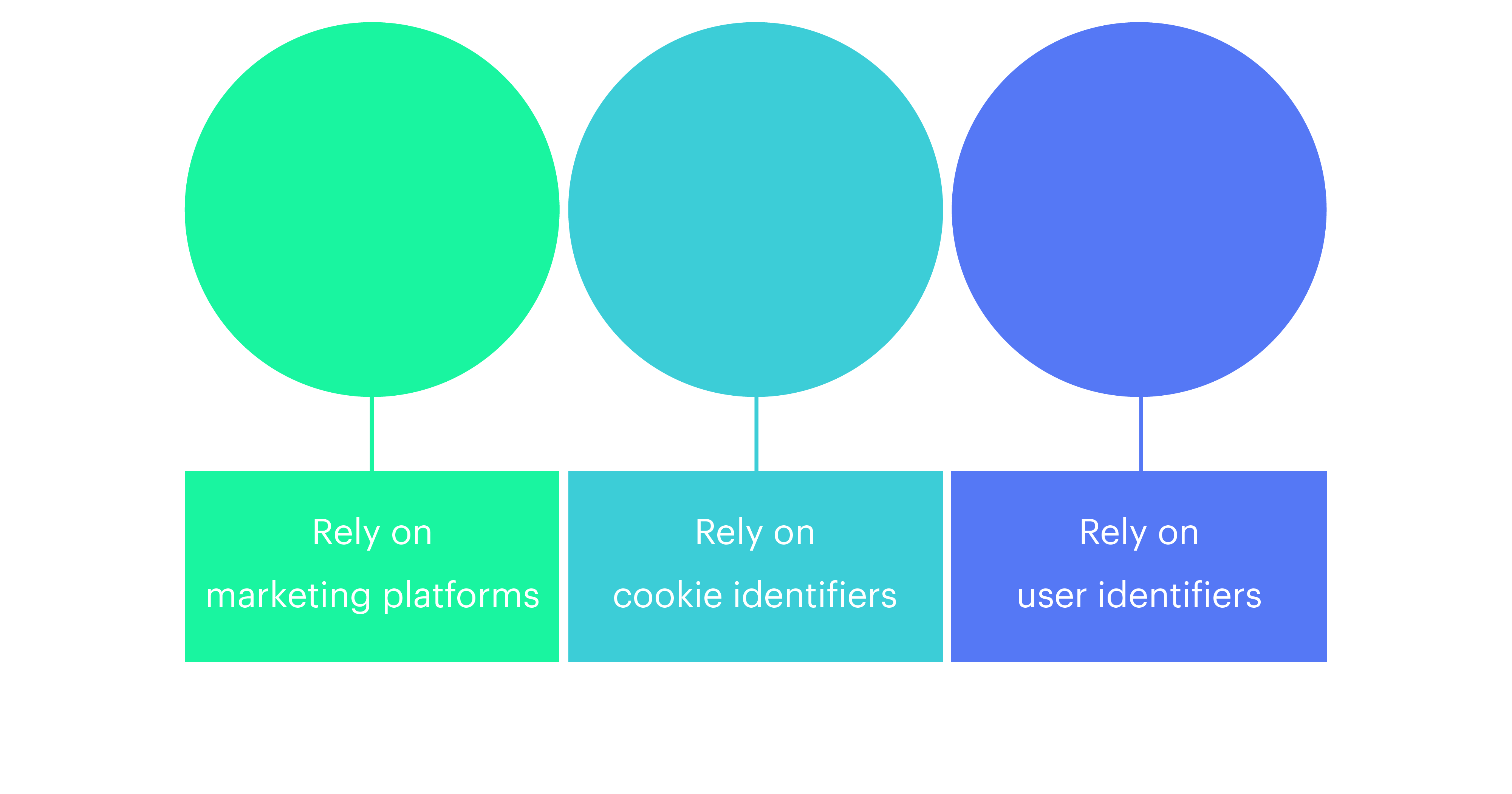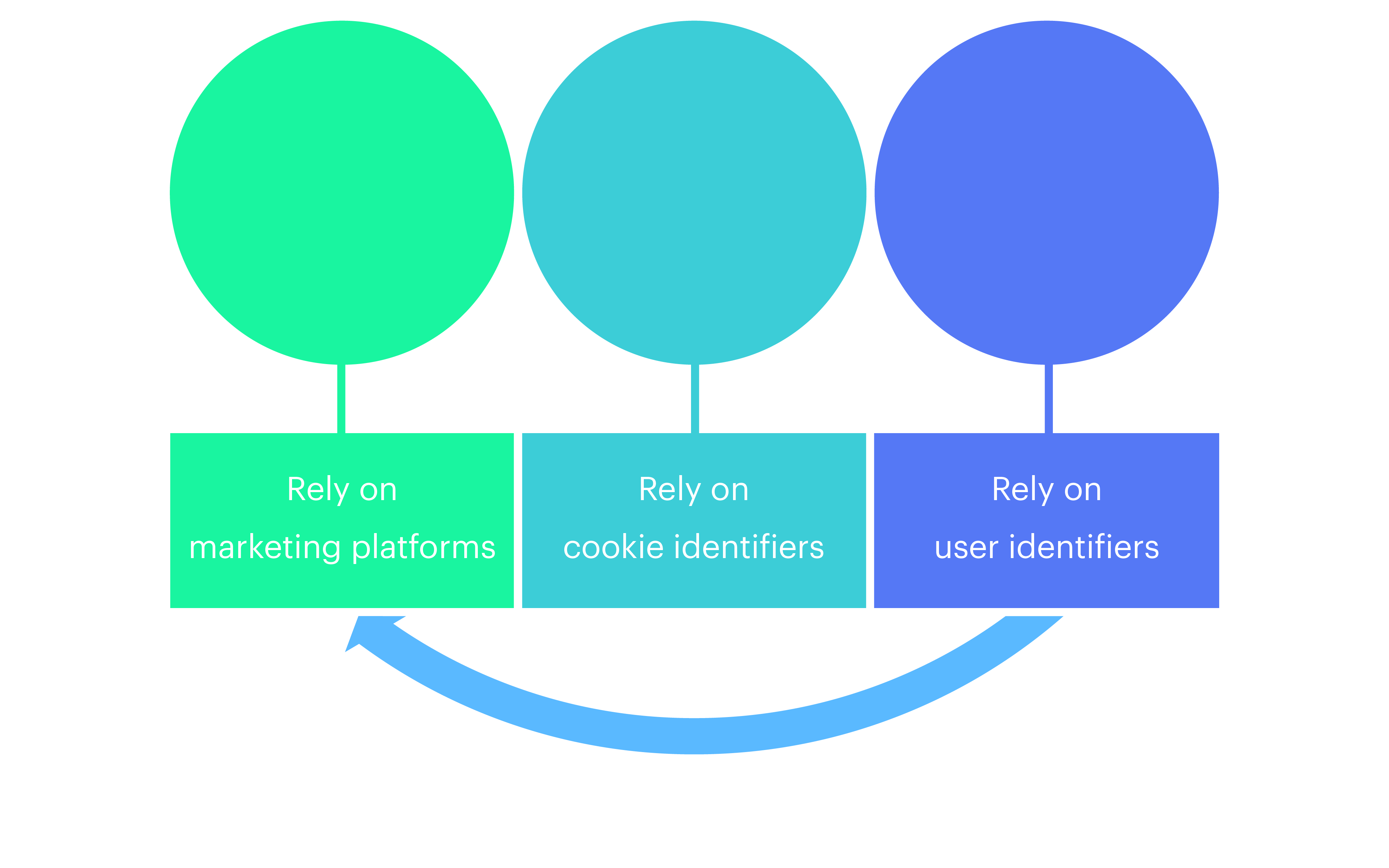What is a ‘user’ anyway?

Joe Whitehead
Analytics Lead
Understanding the different types of user identifiers in digital marketing can be difficult. In this post, Data Specialist Joe Whitehead breaks it down for you, providing the opportunities, challenges and privacy considerations associated with each type of user identifier in digital marketing.
The word ‘user’ is ubiquitous within digital marketing. However, what is meant by the word ‘user’ can mean very different things depending on the context. This blog aims to provide some clarity by focusing on the different types of user identifiers that are commonly used. We’ll present the opportunities, challenges and privacy considerations that each approach provides within digital marketing.
Identity Landscape
When we browse the internet, many identifiers are created for us by the different websites and companies that we interact with. Anytime you log into a platform with an email address or consent to marketing cookies on a website, a type of identifier is being used or created. This complex ecosystem of multiple identifiers in various systems is the reality of what a ‘user’ is within digital marketing. A ‘user’ isn’t the simple and single entity it can be portrayed as.
From a company’s perspective, you are interested in how you will find potential customers online through your marketing activity. To provide a framework for navigating this, you can bucket all customers or potential customers into three categories depending on the type of user identifier you have access to. These ‘identity spaces’ can be seen below:
 No identifier
No identifier
The first case we’ll consider when we have no user identifier. When trying to reach new customers online, it’s likely that you won’t be able to work with first-party identifiers until a user engages with your website or app. A first-party identifier is a user identifier that you have collected yourself, for example from website analytics or CRM systems.
When we have no such identifiers, the most effective way to reach your potential customers is through marketing platforms such as Facebook, Google or a programmatic Ad Exchange. This marketing technology works because these companies have their own user identifiers, often associated with attributes such as age, gender, or interests, which marketers may use for advertising. These types of identifiers are sometimes called third-party identifiers because they are not owned by the company purchasing ads.
Knowledge of the available targeting criteria within platforms is the key to successful marketing when trying to reach a specific type of audience within this identity space. The audience targeting criteria provided by Google can be found here. And the core audience options provided by Facebook can be found here. These audience definitions have been created by Google and Facebook themselves and users are bucketed into these categories for you.
The main advantage when working in this identity space is reach. Marketing to users when you have no user identifiers available is one of the core ways to acquire new customers for your business online.
However, relying on third-party data alone is unlikely to drive the best performance. As a performance marketing agency, we want to invest our client’s digital marketing budget in the most intelligent and efficient manner. By only relying on the targeting criteria available within marketing platforms we will not be taking full advantage of the data available to us and will fall short of our performance goals. To drive efficiency and results, we make use of first-party data, the first type of which we will consider is cookie identifiers.
Cookie identifiers
When a potential customer interacts with your website or app, then you may be able to collect first-party data in the form of cookies, so long as all required consent(s) have been obtained and required information given. Cookies are small pieces of data that are stored on a user’s web browser. Cookies contain information that can persist over time, such as shopping basket information, authentication credentials, or in the case of many marketing platforms a randomly generated number used to differentiate users. To view the cookies stored on your browser, follow the instructions for your browser here.
Even if our potential customer hasn’t provided any additional information, we can use data from their navigation of your website for a variety of purposes.
Onsite optimisation and A/B testing to improve the performance of your website or app can be done using only cookie identifiers. Heatmapping tools can also provide insight into the granular behavior of individuals across your website or app.
One of the more important ways in which cookie identifiers are used within digital marketing is for segmentation. For example, which of your cookie identifiers have added an item to a shopping basket, which cookies have interacted with your live chat, or which cookies left the site immediately? These segments form the basis of web analytics and remarketing activity. Using cookies to create audience lists is an essential part of improving digital marketing performance.
It is important to keep in mind that the role of cookies within digital marketing is currently changing. Applicable legislation (e.g. in the EU) requires the user’s active cookie consent before setting certain types of cookies in their browser, leading to a reduction in the amount of data that can be collected in many cases. And since the introduction of Safari’s ITP 2.2, the life span of some first-party cookies on the Safari browser is limited to 24 hours. These developments, along with rapid changes in consumer perception of online privacy, have had a large impact on the ways in which advertisers must think about the use of cookies for digital marketing. Transparency, consent, and ownership of data are more important than ever.
User identifiers
The final identity space we’ll consider in this blog post is the user identity space. When the potential customer who was browsing your website or app submits personally identifiable information to your company (e.g. creating an account for your service, submitting delivery information, signing up for a mailing list etc.) then we have the ability to create a user identifier. User identifiers come in many varieties (e.g. account identifiers, address details, email addresses etc.) and will differ depending on the nature of your service. However, all of these identifiers share certain characteristics.
User identifiers are more robust than cookie identifiers as they will persist over time and don’t depend on browser storage. This allows us to overcome many of the challenges faced when working with cookie identifiers (cross-device / cross-browser tracking, shorter life span etc.).
Once we know who the user is, it is oftentimes because they have already ‘converted’. And this identity space can therefore be overlooked within digital marketing activity in favour of new user acquisition. However, we’ve found that many businesses would benefit from taking more care of their user data. We’ve already written a blog about actioning your customer data, and have provided some additional ideas below:
- Customer matching
Both Facebook and Google have customer matching capabilities. By uploading user identifiers directly to these platforms and providing user identifiers to match with their known user base, we can create audiences for digital marketing without the need for cookie identifiers. The common identifiers used for this customer matching are email addresses and phone numbers.
Customer matching best practices for Facebook can be found here and the Google help page on customer match can be found here. Some example actions of customer match are as follows:
- Similar audiences
Both Facebook and Google provide the ability to create similar audiences via custom audience uploads. By defining audience lists that have similar characteristics to known high-value users, you are able to acquire new users more efficiently. - Negative audience lists (recommended due to cookie concerns)
Traditionally, to prevent a user from viewing an ad after they have made a conversion on your website, you would create an audience list of all of the cookies that have triggered the conversion event and exclude them from marketing activity. However, with the recent changes to cookies that we have discussed, we recommend using all relevant user identifiers at your disposal to prevent this situation rather than just relying on cookies.
By utilising user identifiers for customer matching, we can begin to navigate the “rely on marketing platforms” space more intelligently to create more effective digital marketing.

Privacy
As user identifiers can be directly or indirectly linked to an individual and are therefore considered personal data, privacy considerations become paramount. We’ll explore privacy considerations in more detail in a future blog post, but for now, keep in mind that you will need to ensure a proper legal ground (such as consent) for all your processing of personal data and that your company and any third parties that you work with comply with applicable privacy legislation, as well as applicable marketing platform policies and terms when working with user identifiers.
As a user of the internet, it is good to know what you can and should expect from a company regarding how they handle your data. Firstly, you should be made aware of what data will be collected and how the company intends to use and share your data (hopefully this blog has helped provide some context on how companies might use the data that they collect). If you are in the EU, then you can expect a company to comply with the GDPR as well as the ePrivacy Directive. We won’t cover all of these rights in detail, but some highlights include the ‘right to be informed’, where a company must provide you with certain information such as the purposes of the processing, as well as the ‘right to be forgotten’ where a company must delete your personal data from their systems if certain conditions are met (e.g. if the data is no longer necessary for the purpose it was collected for).
A note on first-party data
As the digital marketing landscape starts to consist of more “walled garden” environments, a one-ecosystem audience targeting approach limits our ability to find potential customers. Therefore, strong management of your first-party data and the relevant user identifiers that come along with it is becoming increasingly important within digital marketing.
At Precis we’re big fans of using Google Cloud Platform and BigQuery to provide a cheap, highly accessible and easy-to-use data warehouse to store your first-party data. When you start working with data in this environment, then knowing the identifiers present across your organisation and how they are allowed to be used becomes very important. In the world of data warehousing, identifiers = join keys.
Summary
Digital marketing can be a complicated world to navigate, and the widespread use of the word ‘user’ can make it hard to understand what’s really going on. We hope this blog has provided a useful framework for thinking about your audiences and the data you have and maybe even inspired you into action!
If you’d like to discuss audience strategy or data warehousing for your business, please do get in touch with us at hello@precisdigital.com.
Glossary
Pseudonymous Identifiers are identifiers that can’t be used to directly define a person. An example of this identifier would be the account ID “ABC123”. It is a unique identifier as it can be used to identify the behavior of an individual account, however, it is also pseudonymous because we can’t determine who “ABC123” refers to without the use of additional information.
First-party data is defined as data that you ‘own’. It consists of the data that you have collected yourself about your users. In the context of digital marketing, the first-party data that will contain user identifiers usually consists of website analytics and CRM systems.
Cookies are small pieces of data that are stored on a user’s web browser. Cookies contain information that can persist over time, such as basket information and authentication credentials. To view the cookies stored on your browser, follow the instructions for your browser here.
Example Identifiers
Some common digital marketing identifiers that establish who someone is are shown below.

Some common digital marketing identifiers that establish what something is are shown below. These identifiers are often used in conjunction with user identifiers to determine the actions a user has taken.



